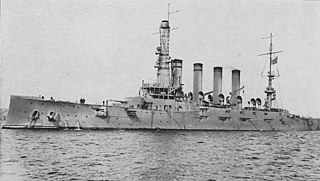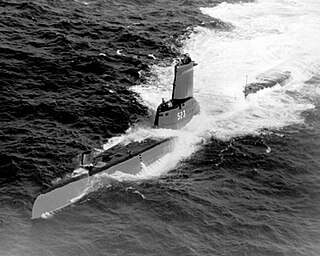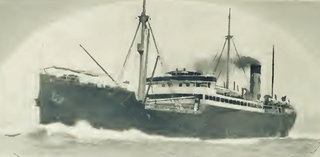Eight ships of the United States Navy and United States Revenue Cutter Service have been named USS Massachusetts, after the Commonwealth of Massachusetts.

The second USS Maryland (ACR-8/CA-8), also referred to as "Armored Cruiser No. 8", and later renamed Frederick, was a United States Navy Pennsylvania-class armored cruiser.

USS Grampus (SS-523), a Tench-class submarine, was the seventh ship of the United States Navy to be named for two members of the dolphin family (Delphinidae): Grampus griseus, also known as Risso's dolphin, and orca, also known as the "Killer Whale." Her keel was laid down on 8 February 1944 at Boston Navy Yard. She was launched on 16 December 1944, but World War II ended before she was completed, and she sat idle until construction resumed in 1948. On 26 October 1949, she was both christened and commissioned, with Commander George F. Sharp in command.

USS Grampus (SS-4), a Plunger-class submarine later named A-3, was the fourth ship of the United States Navy to be named for a member of the dolphin family, Grampus griseus.

The New York Shipbuilding Corporation was an American shipbuilding company that operated from 1899 to 1968, ultimately completing more than 500 vessels for the U.S. Navy, the United States Merchant Marine, the United States Coast Guard, and other maritime concerns. At its peak during World War II, NYSB was the largest and most productive shipyard in the world. Its best-known vessels include the destroyer USS Reuben James (DD-245), the cruiser USS Indianapolis (CA-35), the aircraft carrier USS Kitty Hawk (CV-63), the nuclear-powered cargo ship NS Savannah, and a quartet of cargo-passenger liners nicknamed the Four Aces.

USS T-2 (SS-60) was an AA-1-class submarine built for the United States Navy during World War I.

Union Iron Works, located in San Francisco, California, on the southeast waterfront, was a central business within the large industrial zone of Potrero Point, for four decades at the end of the nineteenth and beginning of the twentieth centuries.

The first USS Patterson (DD-36) was a modified Paulding-class destroyer in the United States Navy during World War I and later in the United States Coast Guard, designated as CG-16. She was named for Daniel Patterson.

The United States Fish Commission, formally known as the United States Commission of Fish and Fisheries, was an agency of the United States government created in 1871 to investigate, promote, and preserve the fisheries of the United States. In 1903, it was reorganized as the United States Bureau of Fisheries, which operated until 1940. In 1940, the Bureau of Fisheries became part of the newly created Fish and Wildlife Service, under the United States Department of the Interior.

USS Savannah was a submarine tender in the United States Navy in World War I and the years after. She was launched 18 April 1899 as a German commercial freighter SS Saxonia, but was seized by the United States in 1917 and renamed Savannah. In 1933, the ship was renamed USS AS-8 to allow USS Savannah to have the Savannah name.

USS Wilhelmina (ID-2168) was a transport for the United States Navy during World War I. Built in 1909 for Matson Navigation Company as SS Wilhelmina, she sailed from the West Coast of the United States to Hawaii until 1917. After her war service, she was returned to Matson and resumed Pacific Ocean service. In the late 1930s she was laid up in San Francisco, California, until sold to a British shipping company in 1940. While a part of a convoy sailing from Halifax, Nova Scotia, to Liverpool, she was sunk by U-94 on 2 December 1940.

USS Remlik (SP-157) was a yacht acquired by the U.S. Navy during World War I. She was converted into an armed patrol craft and assigned to protect ships from German submarines in the North Atlantic Ocean. Post-war she was decommissioned, stripped of naval ordnance and sold in Norfolk, Virginia.
USS Nina was a United States Navy steamer commissioned in 1866. She served in a variety of roles — as a tug, torpedo boat, torpedo boat tender, salvage ship, supply ship, and submarine tender — before she sank in a storm in 1910.

The second USS Calypso (SP-632) was a United States Navy patrol vessel in commission from 1917 to 1919. She originally operated as the private motorboat Calypso from 1909 to 1917. After the conclusion of her U.S. Navy career, she served as the fishery patrol vessel in the United States Bureau of Fisheries fleet from 1919 to 1940 as USFS Merganser and in the Fish and Wildlife Service fleet as US FWS Merganser from 1940 to 1942.
The second USS Yosemite was a steamer of the United States Navy that served briefly as a tender.

USFC Phalarope was an American fish culture and fisheries science research vessel that operated along the coast of New England. She was part of the fleet of the United States Commission on Fish and Fisheries, generally referred to as the United States Fish Commission, from 1900 to 1903 and in the fleet of its successor, the United States Bureau of Fisheries, as USFS Phalarope from 1903 until 1917 and again from 1919 until fiscal year 1933. She was in commission in the United States Navy as the patrol vessel USS Phalarope from 1917 to 1919, seeing service during World War I. Before her United States Government service, she was the steam yacht Adelita.

Craig Shipbuilding was a shipbuilding company in Long Beach, California. To support the World War 1 demand for ships Craig Shipbuilding shipyard switched over to military construction and built: US Navy Submarines and Cargo Ships. Craig Shipbuilding was started in 1906 by John F. Craig. John F. Craig had worked in Toledo, Ohio with his father, John Craig (1838-1934), and Blythe Craig, both shipbuilders, their first ship was built in 1864 at Craig Shipbuilding Toledo. John F. Craig opened his shipbuilding company in Port of Long Beach on the south side of Channel 3, the current location of Pier 41 in the inner harbor, becoming the port's first shipyard. In 1907 Craig Shipbuilding is given a contract to dredge a channel from the Pacific ocean to the inner harbor. In 1917 Craig sold the shipyard to the California Shipbuilding Company. But then opened a new shipyard next to the one he just sold and called it the Long Beach Shipbuilding Company. The Long Beach Shipbuilding Company built cargo ships in 1918, 1919, and 1920 for the United States Shipping Board.












